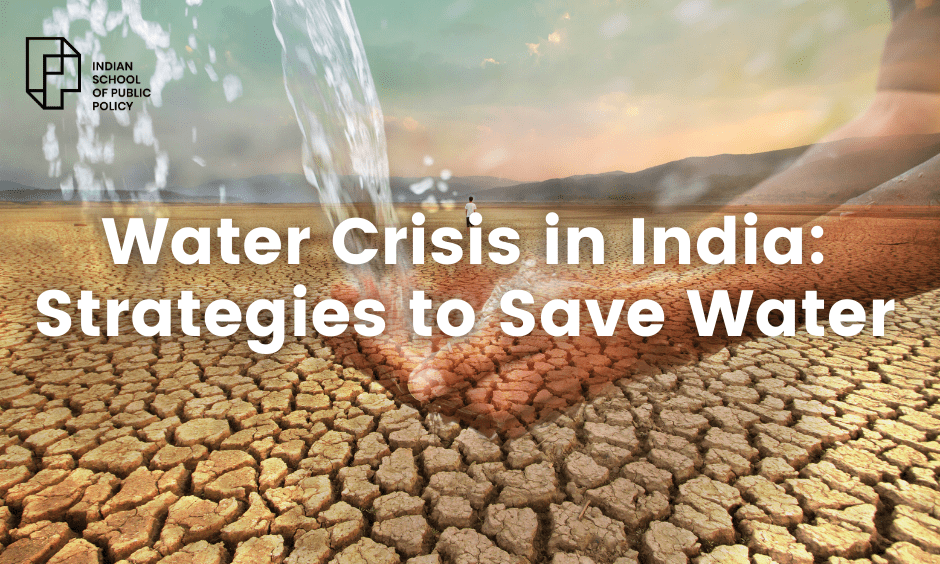
Water Crisis in India: Strategies to Save Water

The past few years have witnessed an increase in the occurrence of natural disasters globally such as the devastating bushfire in 2020 in Australia that decimated the Koala bear population and the wildfire in 2021 in the Amazon rainforest that smothered a vast area of Brazil in smoke for several days at length.
Back home in India, we’ve seen incidences of forest fires reported across the hilly states of Uttarakhand and Himachal Pradesh, cyclones in the coastal states of West Bengal and Odisha, and heavy floods in Assam and Kerala. Flash floods in Himachal Pradesh and Uttarakhand indicate melting Himalayan glaciers as a result of climate change.
Such frequent calamities signal the gravity of climatic changes taking place in India and around the world which aren’t only impacting mankind and nature alike in the current context but are an impending threat to future generations also. Apart from being a major threat to the health and security of its citizens and causing loss of lives, natural disasters can significantly damage a country’s infrastructure and ecosystem. The aftermath of a natural tragedy can cause economic turmoil in a nation owing to such destruction and a lack of resources under such circumstances can further burden its economy with monetary issues.
The severe heatwave sweeping across parts of North and Central India this summer is yet another stark reminder of global warming and how this drastic change in climate would impact lives in urban, suburban, and rural India especially pertaining to the availability of water. The lack of adequate water is not just a mundane matter but a serious threat to India’s economy as it is largely dependent on agriculture, 51% of its agricultural land being rainfed. It can further worsen into a health crisis and famines since water is an element crucial for all life forms, be it humans, plants, or animals.
Statistics reflect India, despite being one the most populous nations in the world, has only 4% of its freshwater resources. This makes water conservation one of the most critical issues the country faces today, given the gargantuan size of its population which accounts for 18% of the world’s population. Additionally, an unpredictable monsoon, extremities in weather conditions as a consequence of climate change, and the country’s proneness to floods and droughts make it all the more serious.
There are an array of challenges India is facing today relating to water conservation and management such as water pollution, sanitation, water scarcity, and climate change but perhaps the most pertinent that remains is the decreasing level of groundwater due to overexploitation. The importance of groundwater is understated. Further depletion of India’s groundwater reserve can lead to a severe water crisis in the future if not managed properly. Groundwater supplements water bodies like ponds, rivers, and lakes which provide water for domestic usage across cities and villages in India. Besides India being an agrarian economy, groundwater is used extensively in agriculture for irrigation purposes in rural India. There is a pressing need to replace old methods of irrigation such as tube well irrigation and flood irrigation that resulted in indiscriminate water loss with newer ones such as micro-irrigation, which improve the overall efficiency of water usage.
Also read: Why Study Public Policy? What Makes It Important Now More Than Ever?
The Indian government has come up with several initiatives to address water conservation. The Ministry of Jal Shakti was formed in 2019 and the Jal Jeevan Mission was launched in the same year to ensure that safe drinking water is provided to all rural households by 2024 through tap connections. The Jal Jeevan Mission Dashboard provides all relevant data and figures reflecting the availability and distribution of water across households in Indian states, districts, blocks, panchayats, and villages. The government also launched a countrywide campaign, Jal Shakti Abhiyan for saving rainwater. Furthermore, the government’s community-led project for effective groundwater management, Atal Bhujal Yojana has been implemented across several water-stressed states in India such as Rajasthan, Madhya Pradesh, Uttar Pradesh, Gujarat, Karnataka, Haryana, and Maharashtra.
The most paramount directive for India at the moment is an urgent need for an individual, collective, and conscious effort to reduce water wastage. A collaborative public-private partnership would ensure this. Experts from different domains such as scientists, environmentalists, activists, policy analysts, and government officials should be engaged to tackle water-related problems under a single governing body. Moreover, water literacy amongst the masses is very crucial. Social media campaigns and the deployment of technology can be successfully used to raise awareness relating to the seriousness of the water situation. One such example illustrating this was the #ShowerKiSachchai campaign launched by Mahindra Lifespace Developers Limited, an arm of Indian global conglomerate Mahindra Group in 2019, supporting water conservation. The social media campaign encouraged individuals to reduce water wastage during showers by sharing tips through the medium of a digital video and microsite. However, this may vary amongst the urban and rural communities. More door-to-door campaigns may help increase awareness in villages. Masses should also be encouraged to utilize traditional rainwater harvesting to save and conserve water. Further enhancement and development of infrastructure such as drainage systems can also help save water in both cities and villages.
The role of academic institutions such as schools, colleges, and research institutes are of utmost significance in contributing toward water conservation action. Environmental Sciences must be made an important part of the curriculum and be integrated with engineering and technology disciplines to form multidisciplinary programs. This would encourage more students to pursue it as a career choice to boost experts in the field. More funding for research projects that focus on developing technologies for efficient irrigation practices, recycling of wastewater, distillation, treatment, and sanitation of polluted water, and working on finding ways to utilise ocean water would definitely help find solutions for water conservation.
There must be more investment in agriculture-related research as well especially relating to water-efficient crops such as maize, pearl millet, and sorghum, and popularizing them in agriculture. A study revealed that employing crop diversification and a change in cropping patterns in areas in central districts in the Indian state of Punjab could curb the fall in water table depth. The analysis also identified that wheat and rice, both water-intensive crops were dominant crops during the kharif and rabi seasons. This could be accomplished by shifting from water-intensive wheat and rice-based cropping system to a less water-intensive system. Furthermore, utilising technologies like sprinkler and drip irrigation systems helps save water and enhance crop production. This would further push for water-saving strategies in agriculture and assure water conservation.
Register your Interest to Study at ISPP
The scope of water conservation goes beyond agriculture, economy, and preserving the earth’s ecosystem. The right to water is a basic human right. Water is crucial for life, for one’s health, and cleanliness, and for maintaining one’s dignity. The United Nations has declared ‘to ensure access to water and sanitation for all’ as Sustainable Development Goal 6, as part of its Sustainable Development Agenda. Access to clean drinking water is essential for the overall prosperity, wellness, and sustenance of human beings.
By Shikha Malik
Class of 2023
FAQs
What is the role of academic institutions towards water conservation?
Academic institutions, such as schools, colleges, and research institutes, play a critical role in contributing to water conservation efforts. To achieve this, Environmental Sciences should be integrated with engineering and technology disciplines to create multidisciplinary programs that will encourage more students to pursue careers in this field. By making Environmental Sciences an essential part of the curriculum, more experts can be created in this area. Funding should also be increased for research projects that focus on developing technologies for efficient irrigation practices, wastewater recycling, distillation, treatment, and sanitation of polluted water, as well as exploring ways to utilise ocean water. These efforts will undoubtedly contribute to finding solutions for water conservation.
What is the scope of water conservation in India?
Water conservation is not only important for agriculture, the economy, and preserving the earth’s ecosystem but also for upholding basic human rights. Access to water is essential for life, good health, hygiene, and maintaining one’s dignity. As part of its Sustainable Development Agenda, the United Nations has recognised access to water and sanitation as a fundamental human right and included it in Sustainable Development Goal 6. Providing access to clean drinking water is crucial for ensuring the well-being, sustainability, and overall development of human beings.
Why should there be increased investment in water-efficient crops?
To ensure water conservation in agriculture, it is essential to increase investment in agriculture-related research, especially focusing on water-efficient crops such as maize, pearl millet, and sorghum, and promoting their cultivation. Studies have shown that crop diversification and a change in cropping patterns in water-scarce areas, such as the central districts of Punjab in India, can help combat the fall in water table depth. Research has identified that the cultivation of water-intensive crops like wheat and rice dominates the kharif and rabi seasons, which could be addressed by shifting towards a less water-intensive cropping system. Technologies like sprinkler and drip irrigation systems can also be employed to save water and increase crop production. Encouraging the use of such water-saving strategies in agriculture will be instrumental in promoting water conservation.
What is the role of the government to tackle water conservation in India?
The Indian government has taken multiple initiatives to tackle water conservation. In 2019, the Ministry of Jal Shakti was established, and the Jal Jeevan Mission was launched to provide safe drinking water to all rural households via tap connections by 2024. The Jal Jeevan Mission Dashboard provides relevant information on the availability and distribution of water across Indian states, districts, blocks, panchayats, and villages. Additionally, the government launched the Jal Shakti Abhiyan campaign nationwide to conserve rainwater. The Atal Bhujal Yojana, a community-led project for efficient groundwater management, has been implemented in water-stressed states such as Rajasthan, Madhya Pradesh, Uttar Pradesh, Gujarat, Karnataka, Haryana, and Maharashtra.


